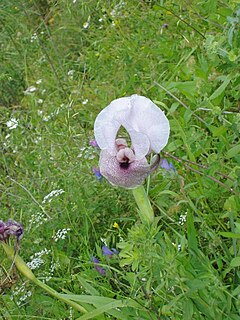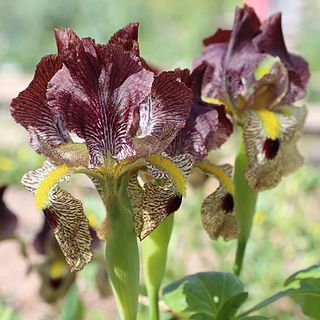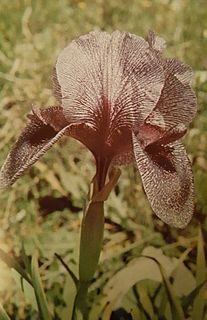Iris latistyla is a plant species in the genus Iris, it is also in the subgenus Limniris and in the section 'Lophiris section, although it was thought to be listed within Iris subg. Nepalensis in some sources. It is a rhizomatous perennial, from Tibet and China, with violet or blue-purple flowers. It is cultivated as an ornamental plant in temperate regions.
Iris sikkimensis is a plant species in the genus Iris, it is also in the subgenus Iris and in the section Pseudoregelia. It is a rhizomatous perennial, from Sikkim. It has pale green or light green thin leaves, slender stem, 2 or 3 lilac or purple flowers, with a white beard with orange tips. It is thought to be a hybrid of Iris hookeriana and Iris kumaonensis.
Iris griffithii is a plant species in the genus Iris, it is also in the subgenus Iris. It is a rhizomatous perennial, from Afghanistan. It has short, sickle-shaped leaves, short green stem and purple flowers with white beards. Several specimens exist within herbaria around Europe, but it is rarely cultivated.
Iris antilibanotica is a species in the genus Iris, it is also in the subgenus Iris. It is a rhizomatous perennial, from the mountains of Syria. It has semi-evergreen, green, falcate leaves, slender stem, bi-coloured flowers, in dark purple, violet. With a small dark spot and purple tipped yellow beard on the outer petals. It is rarely cultivated as an ornamental plant in temperate regions and thought to be extinct in the wild.
Iris assadiana is a species in the genus Iris, it is also in the subgenus Iris. It is a rhizomatous perennial, from the deserts of Syria. It has small rhizomes, grey-green strongly curved leaves, slender stems, scented flowers in April, in shades of maroon, purple, deep purple or black. They have dark veining and it also has yellow/white beard tipped with purple. It is rarely cultivated as an ornamental plant in temperate regions.
Iris barnumiae is a species in the genus Iris; it is also in the subgenus Iris and in the section Oncocyclus. It is a rhizomatous perennial, from Armenia, Azerbaijan, Iran, Iraq, and Turkey. It has pale glaucous green and narrow leaves, that are slightly sickle-shaped and fade soon after blooming. It has, in mid- to late spring, fragrant flowers in shades of purple, from red-purple, mulberry to purplish-violet, with a yellow tipped with purple beard. It was renamed as I. barnumiae in after a plant naming conference in 2011, but is still sometimes named as I. barnumae in some sources. It has one accepted subspecies Iris barnumiae subsp. demawendica and two forms; Iris barnumiae f. protonyma (Stapf) B.Mathew & Wendelbo and Iris barnumiae f. urmiensis (Hoog) B.Mathew & Wendelbo, which has yellow flowers. Sometimes I. barnumiae f. barnumiae is used to describe the basic form. It is rarely cultivated as an ornamental plant in temperate regions, due to its needing very dry and warm summer conditions.

Iris auranitica is a species in the genus Iris, it is also in the subgenus Iris and in the section Oncocyclus. It is a rhizomatous perennial in the Jabal al-Druze region in Syria, where it grows at about 1600 m. It has thin and long, greyish-green, semi-evergreen leaves. In May, it has fragranced flowers, with a dark signal patch and yellow beard with purple tips. It is rarely cultivated as an ornamental plant in temperate regions, as it needs very dry conditions during the summer.
Iris basaltica is a species in the genus Iris, it is also in the subgenus Iris and in the section Oncocyclus. It is a rhizomatous perennial, from the basalt deserts and hillsides of eastern Syria. It has many falcate long leaves, and long stem. Between March and April, it has white or pale green flowers covered in thick purple or black veining and dots or spots. It also has a purple or maroon beard, tipped with yellow. It is rare cultivated as an ornamental plant in temperate regions, due to its environmental conditions of its natural habitat.
Iris heylandiana is a species in the genus Iris, it is also in the subgenus Iris, and in the section Oncocyclus. It is a rhizomatous perennial, from the marshlands or fields of Iraq. It has short, linear or sickle shaped grey-green leaves, slender stem, a single flower in spring, which has a dingy-white, whitish, or pale background, which is covered in many spots or dark veining, in black-purple, brown-purple, or brown violet, or brown shades. It has a dark brown or burgundy brown signal patch and white tinged with yellow or orange white sparse beard. It is rarely cultivated as an ornamental plant in temperate regions, as it needs very dry conditions during the summer.

Iris lortetii is a species in the genus Iris. It has straight grey-green leaves, a 30–50 cm tall stem, and large showy flowers in late spring or mid-summer that come in shades of pink, from white, lilac, pale lavender and grey-purple. It is veined and dotted pink or maroon. It has a signal patch that is deep maroon and a sparse and brown, purple-brown or reddish beard.

Iris paradoxa is a species of flowering plant native to western Asia. It has large upright petals and smaller lower petals, which is unique amongst most iris forms. They come in various shades from white, lavender, mauve, medium purple, violet, dark purple to black. It has a black or purplish black beard on the lower petals. It comes from the region of Transcaucasia, and is found in the countries of Iran,, Turkey, Armenia and in Azerbaijan.

Iris petrana, the Petra iris, is a species in the genus Iris, it is also in the subgenus of Iris and in the Oncocyclus section. It has spring blooming flowers that come in shades from burgundy, dark brown to dark violet and purple. They have yellow or dark 'beards' and flower over sword-like grey-green leaves. It is normally found in the desert sands between the countries of Jordan and Israel.

Iris susiana is a species of plant in the family Iridaceae native to Lebanon. This beautiful and big iris, with a span easily reaching twelve centimeters. It grows nowadays in Lebanon, Syria and Turkey where its survival is seriously threatened by excessive picking.

Iris sari is a species in the genus Iris, it is also in the subgenus of Iris and in the Oncocyclus section. It is from the rocky steppes and hills of Turkey. It has curved or straight leaves, cream, greenish or yellowish flowers which are variable and veined with crimson, purple-brown, reddish brown, reddish-purple or black. It has a dark maroon, rich crimson or brown signal patch and gold or yellow beard.

Iris sprengeri is a species in the genus Iris, it is also in the subgenus of Iris and in the Oncocyclus section. It is from the mountain slopes of Turkey. It has large flowers which are white, silver-white or cream, with purple-red or reddish-brown veining and a golden yellow beard and a dark purple or deep purple-brown signal patch.
Iris kirkwoodiae is a plant species in the genus Iris, it is also in the subgenus Iris and in the section Oncocyclus. It is a rhizomatous perennial, from Syria and Turkey. It has white or pale greenish flowers, heavily covered with dark purple veins or dots, deep purple round signal and a beard of long brown/purple hairs. It is cultivated as an ornamental plant in temperate regions.
Iris meda is a species in the genus Iris, it is also in the subgenus of Iris and in the Oncocyclus section. It is from the desert mountains and hills of Media and has long grey-green leaves with cream, pale yellow or yellow flowers, which have purple or dark brown patches and yellow beards.
Iris nectarifera is a species in the genus Iris, it is also in the subgenus of Iris and in the Oncocyclus section. It is found in Iraq, Syria and southeastern Turkey. It has yellow or cream flowers which have purple veining, a purple signal patch and a yellow beard. It has a known variety from Turkey called I. nectarifera var. mardinensis.
Iris westii is a species in the genus Iris, it is also in the subgenus of Iris and in the Oncocyclus section. It is from the mountain sides of Lebanon. It has curved grey-green leaves, a stem carrying one flower in shades of lilac, white or beige with spotting or veins in a darker shade or violet. The lower petals have deep velvety chocolate or deep violet-black signal patch and a purple beard. It rare and threatened due to habitat destruction, from military actions, overgrazing by goats and other factors.
Iris yebrudii is a species in the genus Iris, it is also in the subgenus of Iris and in the Oncocyclus section. It is from the hillsides of Syria. It has curved leaves, often hiding a single stem and the spring flower is pale yellow, covered in fine spots, veining and has a dark purple signal patch and purple beard.






